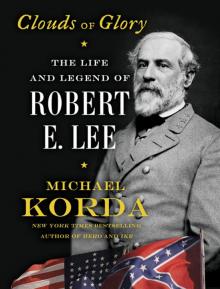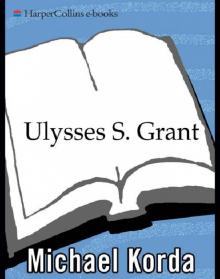- Home
- Michael Korda
Clouds of Glory Page 2
Clouds of Glory Read online
Page 2
In the mid-nineteenth century presidents were by no means as insulated from the communications of ordinary citizens as they are today, and not a few presidents still opened their own mail and read their own telegrams. At the same time, the president of a major railroad was a person of considerable importance, so it is not surprising that Garrett’s message to President James Buchanan reached him without delay early in the morning on October 17 or that he acted on it immediately.
Buchanan was not nicknamed “Old Public Functionary” for nothing: he was an American version of “The Vicar of Bray.” A Pennsylvania Democrat, he had been a congressman, a senator, U.S. minister to Russia, U.S. minister plenipotentiary to the Court of St. James’s, and secretary of state, before winning the presidency in 1856. His service abroad as a diplomat had spared him some of the virulent and passionate political quarrels on the subject of slavery, and he was in any case a “doughboy” (a term of contempt for northerners who were sympathetic to the demands of the slave states), and determined to seek a compromise between southern slave owners and northern abolitionists. Moderation of course gained him no friends on either side of the issue. The only bachelor to have occupied the White House so far, he had lived for fifteen years before his election to the presidency with Senator William Rufus King of Alabama, and it is possible that Buchanan’s views on slavery were influenced by his friendship with King—he remarked in his third annual message to Congress that slaves were “treated with kindness and humanity. . . . Both the philanthropy and the self-interest of the master have combined to produce this humane result,” a rosy view of the institution of slavery that was common enough in Alabama, but unusual in Buchanan’s native Pennsylvania.
Buchanan recognized a crisis when it presented itself, however, and rapidly set in motion as many troops as possible: detachments of regular army infantry and artillery from Fort Monroe, Virginia, and a company of U.S. Marines from the Navy Yard under the command of Lieutenant Israel Green, the only troops available in Washington, were ordered to proceed by train at once to Baltimore and from there to Harpers Ferry, while uniformed companies of the Virginia and Maryland militias (the Hamtramck Guards, the Shepherdstown troop, the Jefferson Guards) had already begun to move into Harpers Ferry and were exchanging fire with John Brown’s outnumbered followers, along with a sizable number of armed and angry citizens and “volunteers,” or vigilantes.
Buchanan’s secretary of war, John B. Floyd, was not efficient, nor would he prove to be loyal—after Harpers Ferry he would be suspected of shipping large numbers of weapons from Federal arsenals in the North to those in the South in anticipation of secession; and in 1862, as a Confederate general, he would abandon his post at Fort Donelson shortly before Grant besieged and took it, for fear he might be tried for treason if he was captured—but he had the good sense to realize that somebody needed to be in command of all these forces converging on Harpers Ferry, and that the right man for the job was at his home in Arlington, just across the Potomac River from Washington.
Robert E. Lee and his wife had inherited the imposing white-pillared mansion that is now the centerpiece of Arlington National Cemetery in 1857 from her father, George Washington Parke Custis, the stepgrandson and adopted son of George Washington. The Arlington property alone comprised 1,100 acres, with a slave population of sixty-three, while two other plantations in Virginia brought the total number of Custis slaves to nearly 200. Custis’s management of his plantations, never his first interest—even a sympathetic fellow southerner described him as “a negligent farmer and an easy-going master”—had further slackened with age and infirmity. The Arlington mansion, while it was something of a museum of George Washington’s possessions (including the bed he died in), was leaking and in need of major, expensive repairs; the plantations were poorly farmed; and the slaves, who had been given to understand that they would be freed on Custis’s death, found instead that their release was contingent on the many other poorly drafted obligations in his will, which looked as if it might drag itself through the courts for years, keeping them in bondage indefinitely.
That this did not make for a happy or willing workforce was only one of the many problems that faced Lee, who, much against his own desire, had taken leave after leave from his post as commander of the recently formed Second U.S. Cavalry at Camp Cooper, Texas, a rough frontier outpost on the Clear Fork of the Brazos River, to devote himself to bringing some kind of order to his father-in-law’s estate. Much as Lee might wish he were back in Texas with his troopers chasing bands of Comanche marauders on the frontier, his sense of obligation and duty to his family kept him at Arlington, “trying to get a little work done and to mend up some things,” as he wrote to one of his sons, adding, “I succeed very badly.”
If so, it was one of the few examples of failure in the life of Robert E. Lee. One of the rare cadets to have been graduated from the U.S. Military Academy with no demerits, he had joined the U.S. Army Corps of Engineers, which in those days got the best and the brightest of cadets, and undertook successfully some of the largest and most difficult public projects of his time, including a safe deepwater channel on the Mississippi that opened up Saint Louis to shipping and caused the mayor of that city to hail him grandly as the man who “brought the Father of the Waters under control.” His service in the Mexican War was at once heroic and of vital importance; his “gallantry” won him universal admiration, as well as the confidence and friendship of General Winfield Scott, who singled Lee out for special praise to Congress.
Lee was later appointed superintendent of the U.S. Military Academy; his leadership at West Point won him the confidence and praise of both the cadets and the War Department, as well as giving him an opportunity to take advantage of its library and study in exhaustive detail the campaigns of Napoleon—a scholarly interest that would pay dividends in the most unexpected way only seven years later when he would become celebrated as the greatest tactician in American military history, as well as “a foe without hate, a friend without treachery, a soldier without cruelty, a victor without oppression . . . a Caesar, without his ambition, Frederick, without his tyranny, Napoleon without his selfishness, and Washington, without his reward.”
Lee was happy enough to give up the Corps of Engineers for active soldiering, and Jefferson Davis, secretary of war (and future president of the Confederacy), was eager to have him as second in command of the newly formed Second Cavalry, for which Davis had long petitioned Congress to reinforce the American military presence on the frontier. For the next six years Lee’s military service was to be of the hardest kind, in places where there was nothing much except lonely space “to attract Indians . . . or to induce them to remain,” and from which he wrote to his wife on July 4, 1856, with a burst of sincere patriotism: “the sun was fiery hot. The atmosphere like the blast from a hot-air furnace, the water salt; still my feelings for my country were as ardent, my faith in her future as true, and my hopes for her advancement as unabated, as if called forth under more propitious circumstances.” Lee eventually rose to succeed Colonel Albert Sidney Johnston, the future Confederate general who would die of his wound at Shiloh, as commander of the Second Cavalry, and it was from his duties as its commanding officer that he had taken leave to see to the interminable problems of his father-in-law’s estate.
Secretary of War Floyd returned from the White House to his office to put in motion the forces that he and President Buchanan had decided to send to Harpers Ferry, and to summon Colonel Lee to the War Department at once. He scrawled a quick note to Colonel Drinkard, chief clerk of the War Department, to write out an order to Lee, which read: “Brvt. Co. R. E. Lee, Lt. Col. 2nd cavalry is assigned to duty according to his Brvt rank & will repair to Harper’s Ferry & take command of the troops ordered to that place. He will direct all the troops from Ft. Monroe to continue their route to that place, Harper’s Ferry. [signed] J. B. Floyd, Secretary of War.” Finding First Lieutenant J. E. B. (“Jeb”) Stuart of the First Cavalry in his waiting room, and si
nce Stuart was actually staying with the Lees at Arlington, Floyd gave him the sealed envelope and asked him to deliver it personally to Lee. Stuart had been a cadet at West Point when Lee became superintendent, and was a close friend of one of Lee’s sons, Custis, who had been a classmate. A Virginian, Stuart was already a young officer of great promise, a natural horseman with a reputation for dash and bravery gained in countless clashes with Indians throughout the West, and for steady competence in the pro- and antislavery warfare of Kansas, during which he had briefly met John Brown in the process getting Brown to release a detachment of pro-slavery Missouri militiamen he had taken prisoner. Stuart, who would become a Confederate hero, a major general, and the greatest cavalry leader of the Civil War, was in civilian clothes—he was there on business, having invented and patented “an improved method of attaching sabers to belts,” for the use of which the War Department paid him $5,000, plus $2 for every belt hook the army bought, not a bad deal for a junior officer*—and set off immediately to Arlington. Stuart must have overheard enough to know that there was a slave insurrection taking place at Harpers Ferry, and once he reached Arlington and handed Lee the envelope, he asked permission to accompany Lee as his aide. Lee was almost as fond of Stuart as he was of his own sons (two of whom would serve under Stuart in the coming war), and agreed immediately. They set off together at once for the War Department—such was the urgency of the message that Lee did not even pause to change into uniform.
Floyd filled both officers in on what he knew—the president of the Baltimore and Ohio Railroad was already criticizing the small number of troops being sent, and hugely overestimating the number of insurrectionists—then took them over to the White House, to meet with the president. President Buchanan quickly provided Lee with a proclamation of martial law to use in case he needed it (by now rumor put the number of armed insurrectionists at 3,000), and both officers left for the station, Stuart having borrowed a uniform coat and a sword.
Horror of a slave revolt resonated sharply for Lee—slave rebellion, with the inevitable massacre of white women and children, was a fear of every white southerner, even without the prospect of northern abolitionists and freed blacks seizing possession of a Federal arsenal to arm the slaves. As a young officer, recently married, Lee had been stationed at Fort Monroe, Virginia, less than forty miles from where Nat Turner’s rebellion took place over two days in August 1831. Led by Turner, the slaves killed fifty-six whites, including women and children, using knives, hatchets, farm implements, and in the case of a young girl whom Turner himself killed, a fence post. In the wake of that rebellion, fifty-six slaves were executed and at least 200 more killed by the militia, white mobs, and vigilantes, while the state of Virginia passed laws forbidding the education of slaves and freed blacks, and “requiring white ministers to be present at black church services,” since the rumor was that Turner had planned his uprising in church between gospel sermons to his fellow slaves. Lee himself felt no great enthusiasm for slavery but he had heard the stories of what Nat Turner and his followers had done to their owners and the families of their neighbors from those who had seen the results with their own eyes, and so had no illusions about the consequences of a slave rebellion on a much larger scale.
Lee and Stuart took a train for the Relay House, where the spur line to Washington met the main line from Baltimore to the West, but found that the marines had already left there. The president of the Baltimore and Ohio provided them with a locomotive, and Lee telegraphed ahead to order the marines to halt at Sandy Hook, on the Maryland side of the Potomac about a mile to the east of Harpers Ferry, where Lee and Stuart caught up with them around ten o’clock on the night of October 17, after a smoky, noisy ride standing on the fire plate of the locomotive between the engineer and the fireman. By midnight, Lee, Stuart, Lieutenant Green, and the marines (accompanied by Major W. W. Russell, a marine paymaster) were in Harpers Ferry, and Lee had already appraised the situation as being less serious than was feared in Washington. Learning from the militiamen that the insurrectionists and their hostages were in the fire-engine house of the armory, he quickly telegraphed to Baltimore to halt the dispatch of further troops and artillery, ordered the marines into the armory grounds to prevent any insurrectionists from escaping, and decided to assault the fire-engine house “at daylight.” He would have attacked at once, but feared that the lives of “some of the gentlemen . . . that were held as prisoners” might be sacrificed in a night assault.
One can sense, even in Lee’s brief report after the event, the firm hand of a professional soldier taking over. With exquisite politeness, he offered the honor of forming “the storming party” to the commander of the Maryland Volunteers, who declined it with remarkable candor, saying, “These men of mine have wives and children at home. I will not expose them to such risk. You are paid for doing this kind of work.” The commander of the Virginia militia also declined the honor (referring to the marines as “the mercenaries”), as Lee surely guessed he would—a lesson for the future, if Lee needed one, about the value of state militias—and he therefore ordered Lieutenant Green to “take those men out,” which is what he probably wanted in the first place, since Green was a professional and the marines were well-trained, reliable regulars. Calmly, Lee surveyed the ground, moved the militiamen back out of the way, and sat down to write a message to the leader of the insurrectionists:
Headquarters Harpers Ferry
October 18, 1859
Colonel Lee, United States Army, commanding the troops sent by the President of the United States to suppress the insurrection at this place, demands the surrender of the persons in the armory buildings.
If they will peacefully surrender themselves and restore the pillaged property, they shall be kept in safety to await the orders of the President. Colonel Lee represents to them, in all frankness, that it is impossible for them to escape; that the armory is surrounded on all sides by troops; and that if he is compelled to take them by force he cannot answer for their safety.
R. E. Lee
Colonel Commanding
United States Troops.
The previous twenty-four hours, almost from the moment he allowed the eastbound train for Baltimore to proceed, had been a succession of disasters and tragedies for John Brown—none of which shook his self-confidence, his courage, or his command over those around him. During the night one of Brown’s followers shot and killed another citizen of Harpers Ferry, while Brown busied himself ordering an early breakfast for his men and his prisoners from the hotel across the street from the gates of the armory, apparently unaware that the Jefferson Guards from Charles Town were already on their way—Dr. Starry’s alarm that a slave uprising led by northern abolitionists was taking place in Harpers Ferry was enough to get the local militiamen moving without even bothering to put on their uniform, together with a second, hastily assembled detachment of armed and angry local citizens.
By ten in the morning gunfire could be heard throughout the town, as Brown and his followers were pinned down in the armory, and by noon the militiamen and volunteers had retaken both bridges, cutting off any chance of Brown’s escape, and were beginning to kill, one by one, those of Brown’s party who were left outside the armory. Brown’s men were spared nothing in the way of torture and desecration. One of them, a “mulatto” named Dangerfield Newby, who had been among those trying to hold the Potomac bridge against the militia, had his ears and his genitals cut off for souvenirs, while sharpened sticks were poked into his wounds as he died in agony. His mutilated corpse was left in the street while hogs rooted at his entrails for the rest of the day. Rather than the slave insurrection that Brown had counted on, he had unleashed mob violence instead.
John Brown was a realist in military matters, and although it was not in his nature to surrender, he soon recognized that he was surrounded by superior numbers and that no slave uprising was going to save him. By noon, the volume of fire had driven him back into the armory’s fire-engine house, a stout brick building
with oak double doors, and he had already made an attempt to negotiate, proposing to release his prisoners in exchange for the right to take his men across the Potomac into Maryland, from which he no doubt hoped they could reach Pennsylvania. The two men he had sent out under a white flag were taken prisoner—the militia and the volunteers were in no mood to honor a white flag—but he soon sent out three more, with dire consequences: despite the white flag they carried, one of them was shot and wounded, and Brown’s son Watson was mortally wounded by a bullet in his guts and dragged back into the fire-engine house.
Brown set his men to work knocking out firing ports to transform the fire-engine house into a makeshift fort, and lashed the big central doors with ropes so as to leave a gap of several inches to fire through. His spirits were undaunted, and his faith in his mission as firm as ever. Even his prisoners, Colonel Washington among them, had come to admire the old man, however strongly they deplored what he was doing. By mid-afternoon, men were falling on both sides—the mayor of Harpers Ferry was shot and killed; Brown’s son Oliver, firing through the gap in the doors, was mortally wounded; two more of Brown’s men were shot as they tried to swim across the river; and one of the men Brown had sent out under a flag of truce was dragged from the hotel where he was being held to the Potomac bridge by the mob and executed—his body fell into the river and drifted to a shallow pool where people used it as “an attractive target” for the rest of the day. It could still be seen for a day or two “lying at the bottom of the river, with his ghastly face still exhibiting his fearful death agony.”
Henry A. Wise, the governor of Virginia, had attempted to reassert some kind of order in Harpers Ferry by appointing Colonel Robert W. Baylor of the militia as commander, and by nightfall Baylor had decided to offer the insurrectionist leader another chance to surrender. He sent an elderly civilian to the fire-engine house with a white handkerchief tied to his umbrella, but this courageous citizen was unable to persuade Brown to agree to an unconditional surrender, and although two more attempts were made, Brown remained defiant—he would not surrender unless he was allowed to leave with those of his men who remained alive, and the bodies of those who had been killed. These were not terms that Colonel Baylor could accept, as Brown must have known.

 Passing
Passing Another Life
Another Life Clouds of Glory
Clouds of Glory Hero: The Life and Legend of Lawrence of Arabia
Hero: The Life and Legend of Lawrence of Arabia Cat People
Cat People Hero
Hero With Wings Like Eagles: A History of the Battle of Britain
With Wings Like Eagles: A History of the Battle of Britain Ulysses S. Grant
Ulysses S. Grant